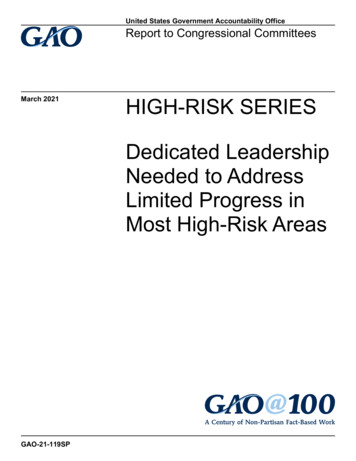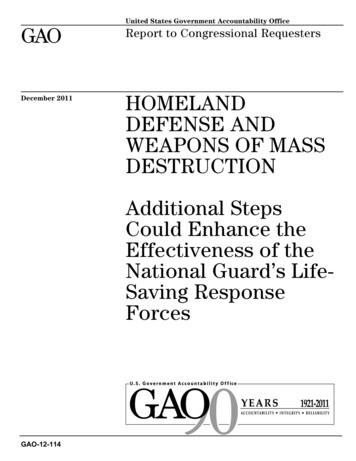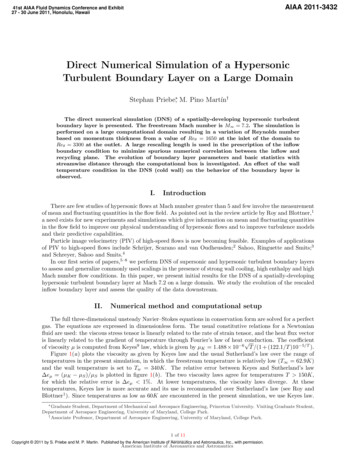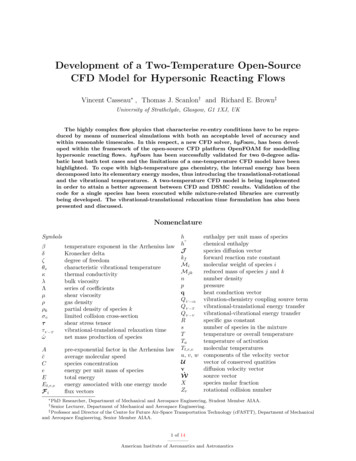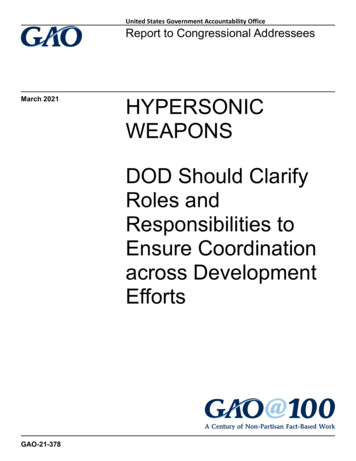
Transcription
United States Government Accountability OfficeReport to Congressional AddresseesMarch 2021HYPERSONICWEAPONSDOD Should ClarifyRoles andResponsibilities toEnsure Coordinationacross DevelopmentEffortsGAO-21-378
March 2021HYPERSONIC WEAPONSDOD Should Clarify Roles and Responsibilities toEnsure Coordination across Development EffortsHighlights of GAO-21-378, a report tocongressional addresseesWhy GAO Did This StudyWhat GAO FoundHypersonic missiles, which are animportant part of building hypersonicweapon systems, move at least fivetimes the speed of sound, haveunpredictable flight paths, and areexpected to be capable of evadingtoday’s defensive systems. DOD hasbegun multiple efforts to developoffensive hypersonic weapons as wellas technologies to improve its ability totrack and defend against them. NASAand DOE are also conducting researchinto hypersonic technologies. Theinvestments for these efforts aresignificant.GAO identified 70 efforts to develop hypersonic weapons and relatedtechnologies that are estimated to cost almost 15 billion from fiscal years 2015through 2024 (see figure). These efforts are widespread across the Departmentof Defense (DOD) in collaboration with the Department of Energy (DOE) and, inthe case of hypersonic technology development, the National Aeronautics andSpace Administration (NASA). DOD accounts for nearly all of this amount.This report identifies: (1) U.S.government efforts to develophypersonic systems that are underwayand their costs, (2) challenges theseefforts face and what is being done toaddress them, and (3) the extent towhich the U.S. government iseffectively coordinating these efforts.This is a public version of a sensitivereport that GAO issued in January2021. Information that DOD deemed tobe sensitive has been omitted.GAO collected and reviewedinformation from DOD, DOE, andNASA to identify hypersonic weaponsdevelopment efforts from fiscal years2015 through 2024. GAO alsoanalyzed agency documentation andinterviewed agency officials.What GAO RecommendsThe Secretary of Defense shoulddefine and document the roles,responsibilities, and authorities of theleadership positions and organizationsin DOD responsible for thedevelopment and acquisition ofhypersonic weapons. DOD concurredwith the recommendation.View GAO-21-378. For more information,contact Jon Ludwigson at (202) 512-4841 orludwigsonj@gao.gov.Hypersonic Weapon-related and Technology Development Total Reported Funding by Type ofEffort from Fiscal Years 2015 through 2024, in Billions of Then-Year DollarsThe majority of this funding is for product development and potential fielding ofprototype offensive hypersonic weapons. Additionally, it includes substantialinvestments in developing technologies for next generation hypersonic weaponsand a smaller proportion aimed at countering hypersonic threats.Hypersonic weapon systems are technically complex, and DOD has takenseveral steps to mitigate some of the challenges to developing them. Forexample, DOD has attempted to address challenges posed by immaturetechnologies and aggressive schedules by pursuing multiple potentialtechnological solutions so that it has options. Other challenges DOD isaddressing relate to industrial base and human capital workforce investmentsneeded to support large-scale production and the availability of wind tunnels andopen-air flight test ranges needed to test hypersonic weapons.DOE and NASA have agreements with DOD on supporting roles, but DOD itselfhas not documented the roles, responsibilities, and authorities of the multitude ofits organizations, including the military services, that are working on hypersonicweapon development. Such governing documentation would provide for a levelof continuity when leadership and organizational priorities inevitably change,especially as hypersonic weapon development efforts are expected to continueover at least the next decade. Without clear leadership roles, responsibilities, andauthorities, DOD is at risk of impeding its progress toward delivering hypersonicweapon capabilities and opening up the potential for conflict and wastedresources as decisions over larger investments are made in the future.United States Government Accountability Office
ContentsLetter1BackgroundDOD Is Conducting Wide-Ranging Efforts to Develop HypersonicTechnologies, with Total Reported Funding of Almost 15Billion from Fiscal Years 2015 through 2024DOD Faces Challenges in Developing and Fielding HypersonicWeapons, but Is Taking Several Steps to Address ThemRobust Collaboration Taking Place, but DOD Lacks GoverningDocumentation to Ensure Efforts are Effective, Efficient, andEnduringConclusionsRecommendation for Executive ActionAgency Comments and Our Evaluation371629353535Appendix IObjectives, Scope, and Methodology39Appendix IIComments from the Department of Defense44Appendix IIIHypersonic Prototyping Development Efforts46Appendix IVTechnology Readiness Levels Numbers and Descriptions47Appendix VGAO Contact and Staff Acknowledgments48TablesTable 1: Phases of Hypersonic Weapon-related and TechnologyDevelopment Efforts between Fiscal Years 2015 through2024Table 2: Department of Defense Offensive Hypersonic Weaponsin Product Development, as of November 2020Table 3: Selected Hypersonic Cruise Missile TechnologyDevelopment EffortsPage i81213GAO-21-378 Hypersonic Weapons
Table 4: Technical Challenge to Developing and FieldingPrototype Hypersonic Weapon Systems and AssociatedMitigation EffortsTable 5: Schedule Challenges to Developing and FieldingHypersonic Weapons and Associated Department ofDefense ExplanationTable 6: Cost Estimating Challenges to Developing and Fielding aHypersonic Weapon and Associated Mitigation EffortsTable 7: Human Capital and Industrial Base Challenges toDeveloping and Manufacturing Hypersonic Weapons andAssociated Mitigation EffortsTable 8: Flight and Ground Testing Challenges to Developing andFielding Hypersonic Weapons and Associated MitigationEffortsTable 9: U.S. Government Organizations Participating inHypersonic Weapon-related and TechnologyDevelopmentTable 10: Key Selected DOD Hypersonic DevelopmentCoordination MechanismsTable 11: Summary of U.S. Hypersonic Weapon Prototypes1719212325303246FiguresFigure 1: Comparison of Ballistic and Hypersonic FlightTrajectoriesFigure 2: Selected Department of Defense Hypersonic WeaponSystem Acquisition PhasesFigure 3: Hypersonic Weapon-related and TechnologyDevelopment Total Reported Funding by Type of Effortfrom Fiscal Years 2015 through 2024, in Billions of ThenYear DollarsFigure 4: Hypersonic Weapon-related and TechnologyDevelopment Efforts Total Reported Funding from FiscalYears 2015 through 2024, in Billions of Then-YearDollarsFigure 5: NASA Langley’s Hypersonic Model Test in the 8-FootHigh Temperature TunnelFigure 6: NASA Langley’s 8-Foot High Temperature TunnelTesting a Large-scale Cone Aerothermodynamic TestArticleFigure 7: Department of Defense Hypersonic CoordinationStructurePage ii46910262733GAO-21-378 Hypersonic Weapons
AbbreviationsDARPADCMADODDOEJHTONASAOSDOUSD (A&S)Defense Advanced Research Projects AgencyDefense Contract Management AgencyDepartment of DefenseDepartment of EnergyJoint Hypersonics Transition OfficeNational Aeronautics and Space AdministrationOffice of the Secretary of DefenseOffice of the Under Secretary of Defense for Acquisitionand SustainmentOUSD (R&E) Office of the Under Secretary of Defense for Research andEngineeringS&Tscience and technologyT&Etest and evaluationTRLtechnology readiness levelTRMCTest Resource Management CenterThis is a work of the U.S. government and is not subject to copyright protection in theUnited States. The published product may be reproduced and distributed in its entiretywithout further permission from GAO. However, because this work may containcopyrighted images or other material, permission from the copyright holder may benecessary if you wish to reproduce this material separately.Page iiiGAO-21-378 Hypersonic Weapons
Letter441 G St. N.W.Washington, DC 20548March 22, 2021Congressional AddresseesHypersonic missiles, which move at least five times the speed of soundand have unpredictable flight paths, are expected to be capable ofevading today’s U.S. defensive systems. 1 For decades, multipleDepartment of Defense (DOD) organizations and other federal agencieshave undertaken various science and technology efforts to develophypersonic technologies. More recently, senior DOD officials have statedpotential U.S. adversaries have made progress in developing hypersonicweapons. In light of the potential threats posed by these developments,DOD has led multiple efforts to further develop its own hypersonicweapons and technologies to provide an offensive capability and improveits ability to track and defend against adversaries. Additionally, otheragencies such as the National Aeronautics and Space Administration(NASA) and the Department of Energy (DOE) have extensive experienceand facilities applicable to developing or testing weapon systems and areeither conducting research into hypersonic technologies or supportingDOD’s hypersonic weapon-related development. The investments forthese efforts are significant, with public reports of DOD spending billionsof dollars.We prepared this report on U.S. government hypersonic weapondevelopment under the authority of the Comptroller General to assistCongress with its oversight responsibilities. This report identifies: (1) U.S.government efforts to develop hypersonic systems that are underway andtheir recent and estimated future costs, (2) challenges these efforts faceto develop hypersonic weapon systems and what is being done toaddress them, and (3) the extent to which the U.S. government iseffectively coordinating these efforts. For the purposes of this report, weconsider hypersonic weapon-related and technology development broadlyin that it can include any system, prototype, component, research, or1Machnumber is the ratio of travel speed relative to the speed of sound. Mach 1 refers totraveling at the speed of sound, and Mach 5 refers to traveling at five times the speed ofsound. The speed of sound varies with temperature and the atmospheric temperaturevaries with altitude. At sea level, the speed of sound is approximately 761 miles per hour.At an example flight altitude for hypersonic weapons, the speed of sound is approximately660 miles per hour.Page 1GAO-21-378 Hypersonic Weapons
technology being pursued by DOD to deliver an offensive hypersoniccapability or to defend against an adversary’s hypersonic weapons.This report is a public version of a sensitive report that we issued onJanuary 15, 2021. 2 DOD deemed some of the information in our January2021 report to be sensitive, which must be protected from publicdisclosure. Therefore, this report omits sensitive information about criticaltechnologies, human capital and industrial base investments, andhypersonic test resources. Although the information provided in this reportis more limited, the report addresses the same objectives as the sensitivereport and uses the same methodology.To identify what U.S. government efforts to develop hypersonic systemsare underway and their costs, we collected information via surveys onhypersonic weapon system development and related research fromofficials directly involved in planning or managing efforts at DOD, DOE,and NASA, which were identified by senior officials and hypersonicexperts as the relevant agencies. 3 At our request, the surveys askedagencies to identify all efforts, classified and unclassified, across thegovernment to develop hypersonic weapons and technologies over a 10year period from fiscal years 2015 to 2024. The surveys includedquestions focused on a range of acquisition and science and technologytopics related to the purpose, schedule, cost, challenges, andcollaboration with the hypersonic community, among other topics. Formore information on our surveys, see appendix I. Additionally, wegathered and analyzed agency documentation, interviewed agencyofficials, and analyzed available budget data.To identify the challenges these efforts face to develop hypersonicsystems, we used survey data, interviewed agency officials, and analyzedagency documentation.2GAO,Hypersonic Weapons: DOD Should Clarify Roles and Responsibilities to EnsureCoordination across Development Efforts, GAO-21-75SU (Washington, D.C.: Jan. 15,2021).3Forthe purposes of this report, we defined a hypersonic system as one that: (1) flies atspeeds of Mach 5 or higher, (2) uses aerodynamic lift for the majority of its flight path, (3)maneuvers while in flight, or (4) includes defensive, tracking, or sensing systems used todefeat an offensive hypersonic missile. This definition intentionally excludes other systemsand technology that meet the Mach 5 velocity portion of the general hypersonic definition,such as intercontinental ballistic missiles, space vehicles, and some projectiles, but thatare not part of the more recent effort to develop hypersonic weapon systems ortechnology.Page 2GAO-21-378 Hypersonic Weapons
To identify the extent to which the U.S. government is effectivelycoordinating hypersonic efforts, we used survey data, reviewed agencydocumentation, and interviewed agency officials. We assessed thisinformation against GAO’s leading practices for interagency collaboration,government standards for internal controls, and Office of Managementand Budget guidance. Appendix I provides additional information on ourscope and methodology.We conducted this performance audit from June 2019 to January 2021 inaccordance with generally accepted government auditing standards.Those standards require that we plan and perform the audit to obtainsufficient, appropriate evidence to provide a reasonable basis for ourfindings and conclusions based on our audit objectives. We believe thatthe evidence obtained provides a reasonable basis for our findings andconclusions based on our audit objectives. We subsequently worked withDOD, DOE, and NASA from January 2021 to March 2021 to prepare thispublic version of the sensitive report. This public version was alsoprepared in accordance with these standards.BackgroundThe U.S. government has invested in hypersonic technology since atleast the 1950s but recently renewed its focus in an effort to developoffensive and defensive weapon systems. Hypersonic missiles fly atdifferent altitudes and trajectories than traditional long-range missiles,such as ballistic missiles. As shown in figure 1, there are generally twovariants of offensive hypersonic missiles in development:1. Hypersonic glide vehicles are launched from booster rockets beforegliding to their targets from higher altitudes in the atmosphere.2. Hypersonic cruise missiles are powered by advanced engines thatuse oxygen in the atmosphere for propulsion during their flight afterthey are launched and accelerated by booster rockets. Consequently,hypersonic cruise missiles fly closer to the Earth than hypersonic glidevehicles.Page 3GAO-21-378 Hypersonic Weapons
Figure 1: Comparison of Ballistic and Hypersonic Flight TrajectoriesNote: Air and sea-launched variants of hypersonic missiles are not pictured.Weapon system development often includes science and technology(S&T) efforts aimed at developing and maturing key technologies. Wehave previously found that DOD prioritizes S&T investments based onnear- and far-term adversarial threats, capability needs, and warfighterrequirements. 4 Successful technology development is a progression fromless mature S&T research to product development in the form of testableprototypes. First, technology development seeks to study or mature the4GAO,Defense Science and Technology: Adopting Best Practices Can ImproveInnovation Investments and Management, GAO-17-499 (Washington, D.C.: June 29,2017).Page 4GAO-21-378 Hypersonic Weapons
most immature technology or determine its feasibility. 5 If successful,technology development may advance and include demonstrations thatattempt to prove a concept or a technology. Next, product development,sometimes using prototypes, attempts to build a system which integratesvarious technologies to prove a system or subcomponent technology. Ifsuccessful, this opens up the possibility the technology could beproduced or inserted into an acquisition program where it could be furtherdeveloped and produced on its own or as part of a larger system,sometimes in significant quantities.The Office of the Under Secretary of Defense for Research andEngineering (OUSD (R&E)) is generally responsible for overseeing earlyphase technology development, including establishing policies on andsupervising all aspects of defense research and engineering, technologydevelopment, technology transition, prototyping, experimentation, anddevelopmental testing activities and programs, including the allocation ofresources for defense research and engineering. This organization alsointeracts with major defense acquisition programs throughout their lifecycles with regard to technical risks. 6 For major defense acquisitionprograms, the staff in OUSD (R&E) conduct assessments in areas suchas technology maturity, interoperability, and cybersecurity.As technologies mature and efforts move toward developing integratedweapons systems, Office of the Secretary of Defense (OSD)-leveloversight for them generally moves to the Office of the Under Secretary ofDefense for Acquisition and Sustainment (OUSD (A&S)). Thisorganization is responsible for establishing policies on and overseeing allmatters relating to acquisition—including (1) system design, development,and production; and (2) procurement of goods and services—andsustainment.DOD made investments into hypersonic weapons prior to fiscal year2015. For example, beginning in fiscal year 2008, OSD funded the5Congress provided DOD’s research labs with several authorities related to managementand operations. One of those authorities, laboratory initiated research authority, asimplemented, provides labs with a means to fund new science and technology projectsthat they consider a priority.6Majordefense acquisition programs generally are those designated by DOD as such orthat have a dollar value for all increments estimated to require eventual total expenditurefor research, development, test, and evaluation of more than 525 million, or forprocurement of more than 3.065 billion, in fiscal year 2020 constant dollars.Page 5GAO-21-378 Hypersonic Weapons
Conventional Prompt Strike program for the purpose of maturinghypersonic glide vehicle technologies and research across DOD. 7 OSD’sprimary goal was to demonstrate relevant technologies through flightdemonstrations. That program continued to be funded by OSD throughfiscal year 2020, extending into the period we are covering in this report.The program also laid the groundwork for the current investments beingmade—especially in regard to hypersonic glide vehicle prototyping efforts.This work involved many projects that funded technology maturation testflights, technical support, booster technology development, and initialcontractor work. In fiscal year 2020, most efforts derived from OSD’sConventional Prompt Strike program transitioned to the services forfurther investment and are now directly funded and overseen by serviceacquisition executives. 8 See figure 2 for a depiction of DOD’s hypersonicweapon system acquisition phases.Figure 2: Selected Department of Defense Hypersonic Weapon System Acquisition Phases7Before2016, this effort was named the Conventional Prompt Global Strike program.8Theterm “service acquisition executive” means the civilian official within a militarydepartment who is designated as the service acquisition executive for purposes ofregulations and procedures providing for a service acquisition executive for that militarydepartment.Page 6GAO-21-378 Hypersonic Weapons
DOD Is ConductingWide-Ranging Effortsto DevelopHypersonicTechnologies, withTotal ReportedFunding of Almost 15 Billion from FiscalYears 2015 through2024Hypersonic weapon-related and technology development is widespreadacross DOD and includes supporting efforts by DOE and NASA, such asbasic hypersonic research and reimbursable testing. 9 Reported receivedand planned future funding substantially increased from fiscal years 2015through 2024 and is currently estimated to total almost 15 billion overthis period. 10 The majority of total funding in this period is directed to theproduct development of offensive hypersonic weapon prototypes. Each ofthe military services is developing its own limited operational capabilitybefore transitioning them to other acquisition programs. Additionally, thereare substantial investments in S&T to develop additional technologies fornext generation hypersonic weapons and acquisition programs. Efforts tocounter hypersonic threats are also focused on maturing technologies,but those represent only a small portion of efforts and total funding for thisperiod.Number of Wide-RangingEfforts Increased in theLast 3 Fiscal YearsWe identified 70 total hypersonic weapon-related and technologydevelopment efforts reported by the U.S. government spread acrossDOD’s military services, research laboratories, and defense agencies, aswell as NASA and DOE in support of DOD. Over 60 percent of theseefforts began after fiscal year 2017, with the remainder having startedpreviously. Based on the 70 efforts we identified through our surveys, weassigned each to one of two of DOD’s hypersonic weapon systemacquisition phases based on the type and goals of the effort. Table 1 liststhe number of efforts by acquisition phase and a general description ofthe efforts by increasing level of maturity. 11 For context, we included athird DOD phase to show that no effort has reached maturity forproduction. We further divided the technology development phase intotwo categories: initial and advanced.9ADOE official reported DOE’s work is funded by and supports DOD efforts except forDOE’s Stockpile Responsiveness Program.10Forthe purposes of this report, “received” or “received funding” refers to DOD, DOE,and NASA data that was provided in the surveys, and indicated past funding received forall sources. “Planned” or “Planned funding” refers to DOD, DOE, and NASA data thatwere provided in the surveys, indicating funding that has been planned for the out years.“Total funding” refers to both reported received and planned funding.11For more information on the hypersonic weapon-related development prototypes, seeappendix III.Page 7GAO-21-378 Hypersonic Weapons
Table 1: Phases of Hypersonic Weapon-related and Technology Development Efforts from Fiscal Years 2015 through 2024Acquisition phaseNumber of effortsTechnologydevelopment65DescriptionInitial technology development focuses on basic and applied research in keytechnologies for future hypersonic development and programs. There are 29 suchefforts focusing on research in aerodynamics, materials, propulsion, chemistry, andsimulations, among other areas. 25 of the efforts are led within research laboratoriesrun by the military services or by research entities funded through the Office of theUnder Secretary of Defense for Research and Engineering. The additional four areunderway at the Defense Advanced Research Projects Agency (DARPA), MissileDefense Agency, and the National Aeronautics and Space Administration.Advanced technology development seeks to develop components and integratesubsystems into technology demonstrators for field experiments and/or tests in asimulated or operational environment. There are 36 such efforts focusing onpropulsion, materials, guidance, control, and communication, among others. Theyinclude 15 efforts at DARPA and the Missile Defense Agency that are maturingtechnologies and incorporating them into testable systems. An additional 21 involvethe Office of the Under Secretary of Defense for Research and Engineering, themilitary services, and DOE (on behalf of DOD) to develop technologies of varyingmaturities.Product development5Product development includes developing offensive prototypes by the Air Force,Army, and Navy. Hypersonic glide vehicle and missile development efforts are invarying stages of maturity.Production0Currently, no hypersonic efforts are in production. The Air Force’s Air-launchedRapid Response Weapon is expected to be the first to achieve a residualoperational capability where production decisions can be made after fielding at theend of fiscal year 2022.Source: GAO analysis of Department of Defense, Department of Energy, and National Aeronautics and Space Administration data. GAO-21-378Note: The Department of Energy also identified 10 additional efforts not counted separately becausethey are funded by the Department of Defense’s product development efforts, such as flight tests, andare not unique efforts. One additional Department of Defense product development effort, theHypersonic Conventional Strike Weapon, was cancelled in early 2020, leaving four ongoing.According to the Air Force, the effort had concluded because it reached critical design review,consistent with Air Force’s original acquisition strategy to carry two programs to that point as a riskreduction effort.Hypersonic Total ReportedFunding is Estimated toTotal Almost 15 Billionfrom Fiscal Years 2015through 2024Based on our analysis of survey responses, we found that total estimatedfunding for hypersonic weapon-related and technology developmentefforts increased substantially between fiscal years 2015 and 2024,including an increase of approximately 740 percent between fiscal years2015 and 2020. Over the entire period, total funding is estimated to totalalmost 15 billion. These estimates do not include any costs related toproduction of hypersonic weapons because DOD has not yet budgetedfor them. See figure 3.Page 8GAO-21-378 Hypersonic Weapons
Figure 3: Hypersonic Weapon-related and Technology Development Total Reported Funding by Type of Effort from FiscalYears 2015 through 2024, in Billions of Then-Year DollarsNote: The total funding does not include test and evaluation operations and modernization as theseare outside of hypersonic weapon-related and technology development efforts. Future year funding isnot yet authorized and subject to change. This information was collected in fiscal year 2020 beforefiscal year 2021 budget requests had been considered. For the purposes of this report, fiscal years2015 through 2020 include reported past funding received, and fiscal years 2021 through 2024include reported future funding planned.As shown in figure 3, the focus of the hypersonic efforts is expected toshift toward product development. Most funding prior to fiscal year 2020was focused on technology development. However, product developmentefforts total almost 9 billion, representing 60 percent of the total fundingduring these 10 fiscal years, and for which most is planned for futureyears.DOD accounts for nearly all, or 98 percent, of the total funding forhypersonic weapon-related and technology development efforts fromfiscal years 2015 through 2024. Based on surveys, Navy efforts accountfor the most within DOD for this period—approximately 43 percent of totalDOD hypersonic weapon and technology development funding. Figure 4Page 9GAO-21-378 Hypersonic Weapons
shows the total funding for hypersonic weapon-related and technologydevelopment efforts across DOD and NASA.Figure 4: Hypersonic Weapon-related and Technology Development Efforts TotalReported Funding from Fiscal Years 2015 through 2024, in Billions of Then-YearDollarsNote: This information was collected in fiscal year 2020 before fiscal year 2021 budget requests hadbeen considered. The Department of Energy (DOE) is not listed in the figure above. However, DOEreported that its hypersonic weapon-related and technology development total funding is comprisedof approximately 8 million for a single effort from fiscal years 2015 through 2024. This effort focuseson initial studies of hypersonic system environmental conditions.We also assessed reported funding related to U.S. government test andevaluation (T&E) resources, which we accounted for outside of theindividual agency efforts in figure 4. DOD officials noted T&E resourcesinclude wind tunnels and open-air flight test ranges that supporthypersonic weapon-related and technology development. The TestResource Management Center (TRMC), which is organizationally withinOUSD (R&E), acts as a coordinating body, directing resources to improvetest infrastructure across DOD for hypersonic system testing along withservice operated facilities and ranges. Our assessment of data providedby TRMC shows approximately 1 billion in total funding dedicated tohypersonic modernization for facilities from fiscal years 2015 through2024.Page 10GAO-21-378 Hypersonic Weapons
However, the actual T&E costs for hypersonic weapon-related andtechnology development efforts government-wide are likely higherbecause (1) the 1 billion amount may not include all facility operationalcosts, (2) hypersonic development efforts are only one of many programsthat use T&E facilities, and (3) some funding for hypersonic efforts cannotbe separated from larger pools of funding. For example, in some cases,the military services reported they do not track data the same way asTRMC to reflect only hypersonic-related costs associated with operatingthese facilities, but can only aggregate the costs to operate them for allprograms that use them. Additionally, NASA reported over 500 milliondedicated to the operation, sustainment, and modernization of facilitiesthat support hypersonic testing, along with other applications. DOEindicated it had no dedicated hypersonic T&E funding within our scope.DOD Has PrioritizedFielding OffensiveHypersonic Weapons inthe Near-TermOur analysis shows that all four ongoing product development efforts inDOD are for offensive weapon systems and they represent 56 percent oftotal funding f
DOD Should Clarify Roles and Responsibilities to Ensure Coordination across Development Efforts . What GAO Found . GAO identified 70 efforts to develop hypersonic weapons and related technologies that are estimated to cost almost 15 billion from fiscal years 2015 through 2024 (see figure). These efforts are widespread across the Department
